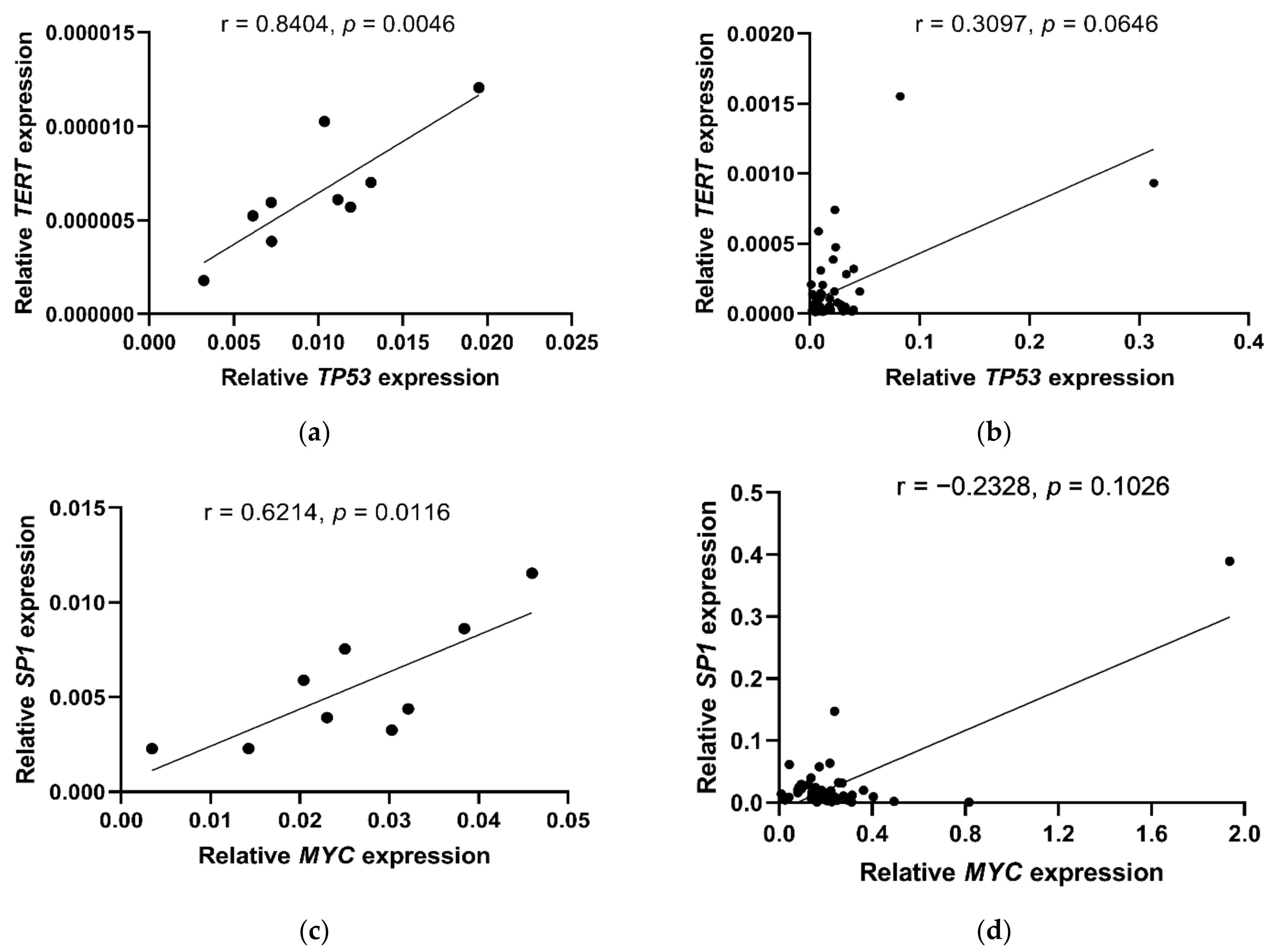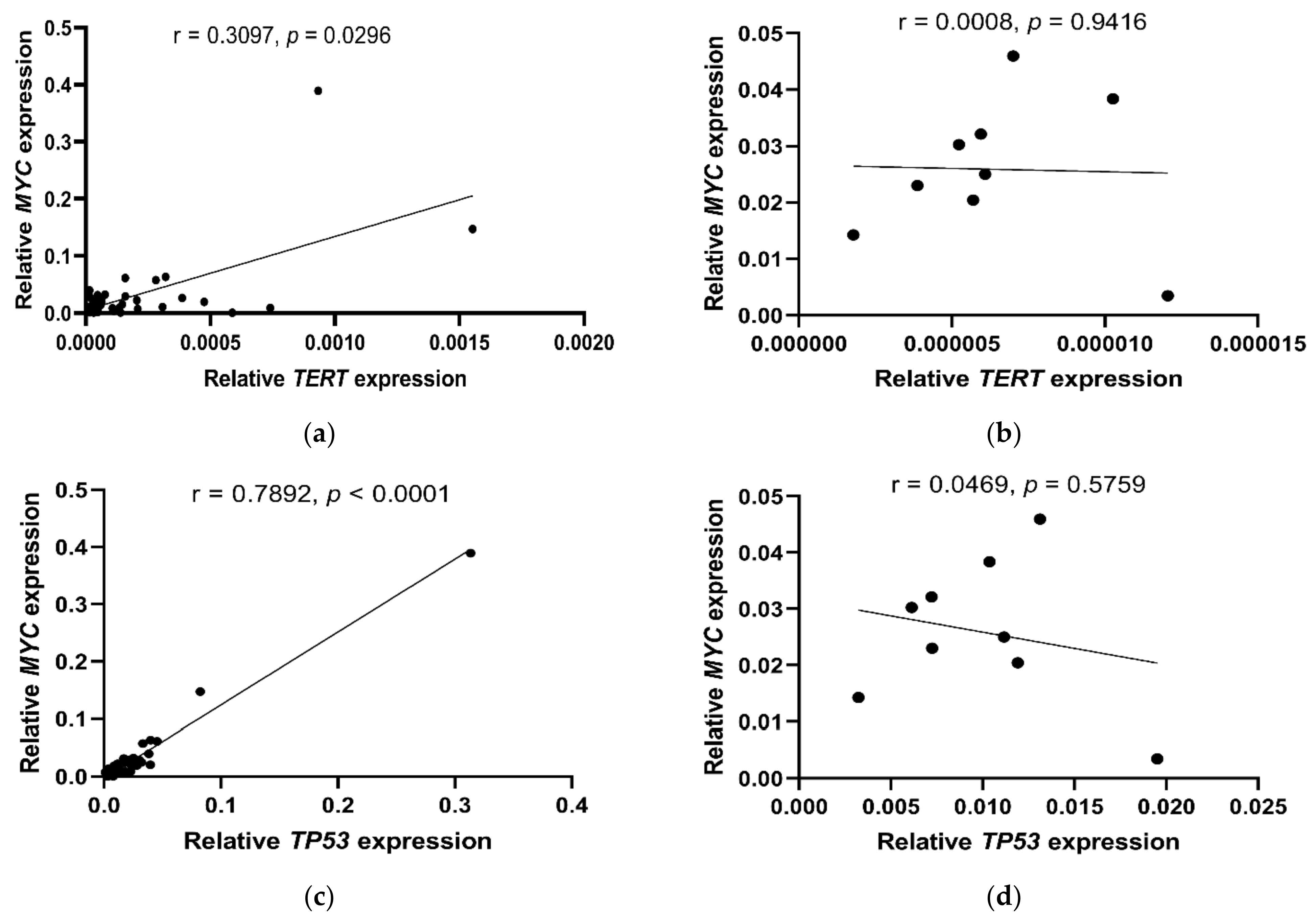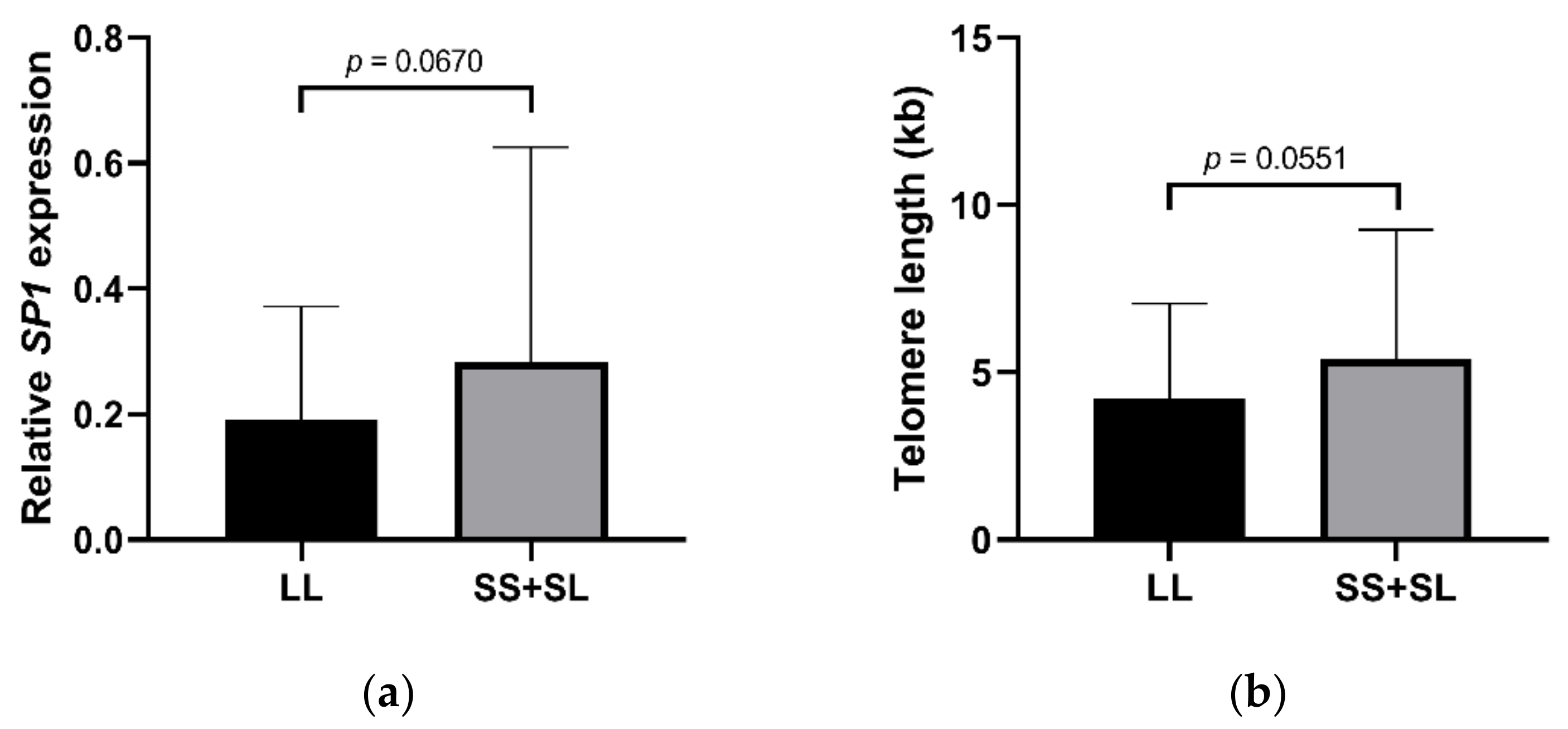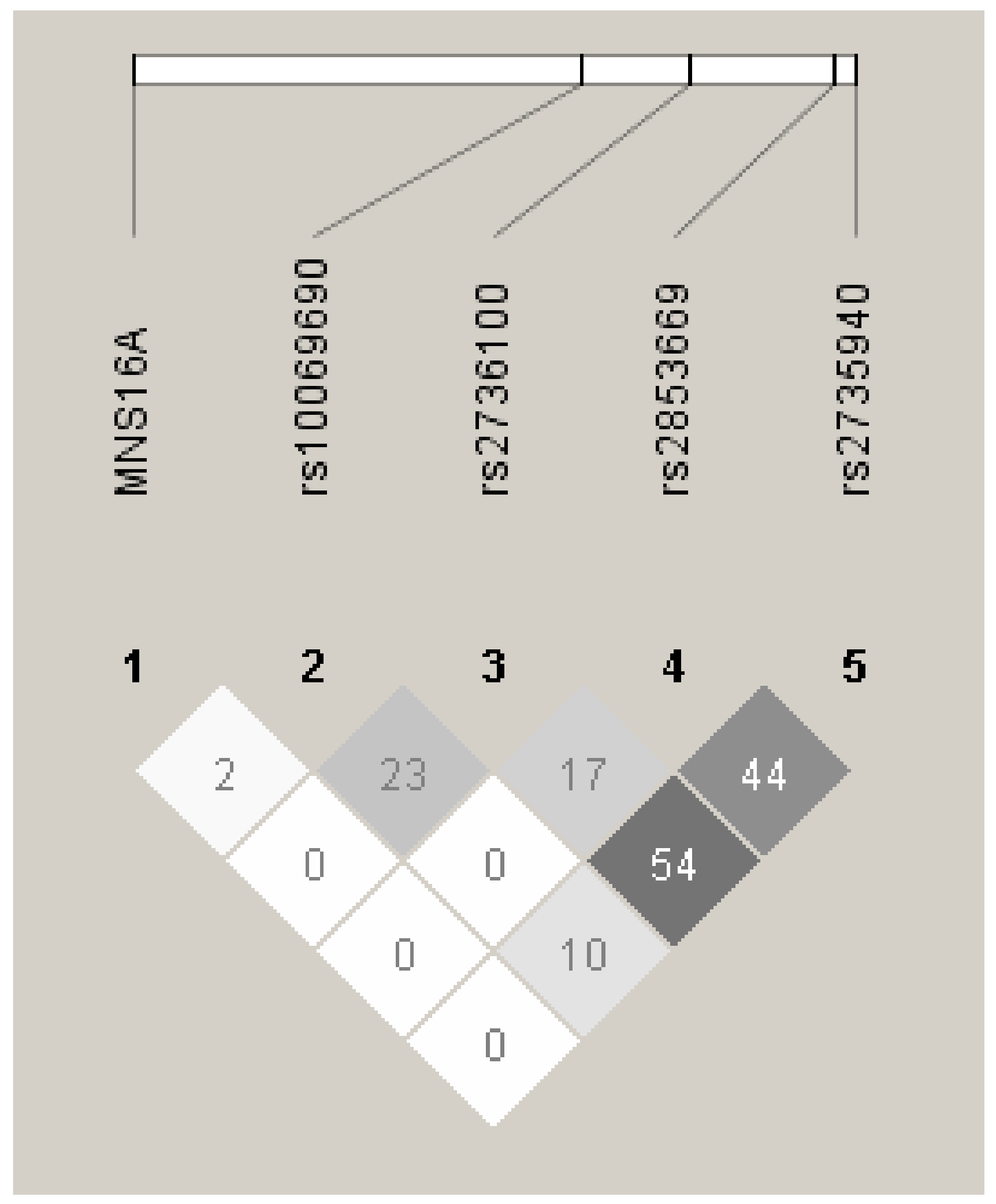Relationship between Telomere Length, TERT Genetic Variability and TERT, TP53, SP1, MYC Gene Co-Expression in the Clinicopathological Profile of Breast Cancer
Abstract
1. Introduction
2. Results
2.1. Disparities of Single Nucleotide and VNTR-MNS16A TERT Gene Polymorphisms in BC
2.2. Relationships between the Expression of TERT, SP1, MYC and TP53 Genes in BC Patients and BC Organoids
2.3. Genetic Variation in TERT, Telomere Length and Expression Level of TP53 and SP1 in BC Patients
2.4. Relationship between Gene Expression, TERT Genetic Variability, Telomere Length and Clinicopathological Hallmarks of Breast Cancer
3. Discussion
4. Materials and Methods
4.1. Patients and Controls
4.2. Breast Cancer Organoids
4.3. DNA Extraction
4.4. Genotyping of TERT Gene Polymorphisms
4.5. VNTR-MNS16A Genotyping of the TERT Gene
4.6. Quantification of Telomere Length
4.7. Extraction of RNA, Reverse Transcription and TERT, SP1, MYC and TP53 Genes Expression Study
4.8. Statistical Analysis
Supplementary Materials
Author Contributions
Funding
Institutional Review Board Statement
Informed Consent Statement
Data Availability Statement
Acknowledgments
Conflicts of Interest
References
- Sung, H.; Ferlay, J.; Siegel, R.L.; Laversanne, M.; Soerjomataram, I.; Jemal, A.; Bray, F. Global Cancer Statistics 2020: GLOBOCAN Estimates of Incidence and Mortality Worldwide for 36 Cancers in 185 Countries. CA Cancer J. Clin. 2021, 71, 209–249. [Google Scholar] [CrossRef] [PubMed]
- Yadav, S.; LaDuca, H.; Polley, E.C.; Hu, C.; Niguidula, N.; Shimelis, H.; Lilyquist, J.; Na, J.; Lee, K.Y.; Gutierrez, S.; et al. Racial and Ethnic Differences in Multigene Hereditary Cancer Panel Test Results for Women with Breast Cancer. J. Natl. Cancer Inst. 2021, 113, 1429–1433. [Google Scholar] [CrossRef] [PubMed]
- Woodward, E.R.; van Veen, E.M.; Evans, D.G. From BRCA1 to Polygenic Risk Scores: Mutation-Associated Risks in Breast Cancer-Related Genes. Breast Care 2021, 16, 202–213. [Google Scholar] [CrossRef] [PubMed]
- Li, Z.Y.; Dong, Y.L.; Feng, Y.; Zhang, Z.; Cao, X.Z. Polymorphisms in the telomerase reverse transcriptase promoter are associated with risk of breast cancer: A meta-analysis. J. Cancer Res. Ther. 2016, 12, 1040–1044. [Google Scholar] [CrossRef]
- Chen, H.; Majumdar, A.; Wang, L.; Kar, S.; Brown, K.M.; Feng, H.; Turman, C.; Dennis, J.; Easton, D.; Michailidou, K.; et al. Large-scale cross-cancer fine-mapping of the 5p15.33 region reveals multiple independent signals. HGG Adv. 2021, 2, 100041. [Google Scholar] [CrossRef]
- Haiman, C.A.; Chen, G.K.; Vachon, C.M.; Canzian, F.; Dunning, A.; Millikan, R.C.; Wang, X.; Ademuyiwa, F.; Ahmed, S.; Ambrosone, C.B.; et al. A common variant at the TERT-CLPTM1L locus is associated with estrogen receptor-negative breast cancer. Nat. Genet. 2011, 43, 1210–1214. [Google Scholar] [CrossRef]
- Savage, S.A.; Chanock, S.J.; Lissowska, J.; Brinton, L.A.; Richesson, D.; Peplonska, B.; Bardin-Mikolajczak, A.; Zatonski, W.; Szeszenia-Dabrowska, N.; Garcia-Closas, M. Genetic variation in five genes important in telomere biology and risk for breast cancer. Br. J. Cancer 2007, 97, 832–836. [Google Scholar] [CrossRef][Green Version]
- Pellatt, A.J.; Wolff, R.K.; Torres-Mejia, G.; John, E.M.; Herrick, J.S.; Lundgreen, A.; Baumgartner, K.B.; Giuliano, A.R.; Hines, L.M.; Fejerman, L.; et al. Telomere length, telomere-related genes, and breast cancer risk: The breast cancer health disparities study. Genes Chromosomes Cancer 2013, 52, 595–609. [Google Scholar] [CrossRef]
- Daniel, M.; Peek, G.W.; Tollefsbol, T.O. Regulation of the human catalytic subunit of telomerase (hTERT). Gene 2012, 498, 135–146. [Google Scholar] [CrossRef]
- Kirkpatrick, K.L.; Clark, G.; Ghilchick, M.; Newbold, R.F.; Mokbel, K. hTERT mRNA expression correlates with telomerase activity in human breast cancer. Eur. J. Surg. Oncol. 2003, 29, 321–326. [Google Scholar] [CrossRef]
- Xu, D.; Dwyer, J.; Li, H.; Duan, W.; Liu, J.P. Ets2 maintains hTERT gene expression and breast cancer cell proliferation by interacting with c-Myc. J. Biol. Chem. 2008, 283, 23567–23580. [Google Scholar] [CrossRef] [PubMed]
- Kyo, S.; Takakura, M.; Taira, T.; Kanaya, T.; Itoh, H.; Yutsudo, M.; Ariga, H.; Inoue, M. Sp1 cooperates with c-Myc to activate transcription of the human telomerase reverse transcriptase gene (hTERT). Nucleic Acids Res. 2000, 28, 669–677. [Google Scholar] [CrossRef]
- Helbig, S.; Wockner, L.; Bouendeu, A.; Hille-Betz, U.; McCue, K.; French, J.D.; Edwards, S.L.; Pickett, H.A.; Reddel, R.R.; Chenevix-Trench, G.; et al. Functional dissection of breast cancer risk-associated TERT promoter variants. Oncotarget 2017, 8, 67203–67217. [Google Scholar] [CrossRef] [PubMed]
- Gay-Bellile, M.; Véronèse, L.; Combes, P.; Eymard-Pierre, E.; Kwiatkowski, F.; Dauplat, M.M.; Cayre, A.; Privat, M.; Abrial, C.; Bignon, Y.J.; et al. TERT promoter status and gene copy number gains: Effect on TERT expression and association with prognosis in breast cancer. Oncotarget 2017, 8, 77540–77551. [Google Scholar] [CrossRef] [PubMed]
- Da Silva, E.M.; Selenica, P.; Vahdatinia, M.; Pareja, F.; Da Cruz Paula, A.; Ferrando, L.; Gazzo, A.M.; Dopeso, H.; Ross, D.S.; Bakhteri, A.; et al. TERT promoter hotspot mutations and gene amplification in metaplastic breast cancer. NPJ Breast Cancer 2021, 7, 43. [Google Scholar] [CrossRef] [PubMed]
- Kroupa, M.; Rachakonda, S.; Vymetalkova, V.; Tomasova, K.; Liska, V.; Vodenkova, S.; Cumova, A.; Rossnerova, A.; Vodickova, L.; Hemminki, K.; et al. Telomere length in peripheral blood lymphocytes related to genetic variation in telomerase, prognosis and clinicopathological features in breast cancer patients. Mutagenesis 2020, 35, 491–497. [Google Scholar] [CrossRef]
- De Souza Rodrigues, K.; Nunes de Matos Neto, J.; Haddad, R.; Madureira de Oliveira, D. Clinical relevance of telomerase polymorphism for breast cancer: A systematic review. J. BUON 2017, 22, 1494–1499. [Google Scholar]
- Vogelstein, B.; Lane, D.; Levine, A.J. Surfing the p53 network. Nature 2000, 408, 307–310. [Google Scholar] [CrossRef]
- Kastenhuber, E.R.; Lowe, S.W. Putting p53 in Context. Cell 2017, 170, 1062–1078. [Google Scholar] [CrossRef]
- Salomao, N.; Karakostis, K.; Hupp, T.; Vollrath, F.; Vojtesek, B.; Fahraeus, R. What do we need to know and understand about p53 to improve its clinical value? J. Pathol. 2021, 254, 443–453. [Google Scholar] [CrossRef]
- Miller, L.D.; Smeds, J.; George, J.; Vega, V.B.; Vergara, L.; Ploner, A.; Pawitan, Y.; Hall, P.; Klaar, S.; Liu, E.T.; et al. An expression signature for p53 status in human breast cancer predicts mutation status, transcriptional effects, and patient survival. Proc. Natl. Acad. Sci. USA 2005, 102, 13550–13555. [Google Scholar] [CrossRef] [PubMed]
- Marei, H.E.; Althani, A.; Afifi, N.; Hasan, A.; Caceci, T.; Pozzoli, G.; Morrione, A.; Giordano, A.; Cenciarelli, C. p53 signaling in cancer progression and therapy. Cancer Cell Int. 2021, 21, 703. [Google Scholar] [CrossRef] [PubMed]
- Parikh, N.; Hilsenbeck, S.; Creighton, C.J.; Dayaram, T.; Shuck, R.; Shinbrot, E.; Xi, L.; Gibbs, R.A.; Wheeler, D.A.; Donehower, L.A. Effects of TP53 mutational status on gene expression patterns across 10 human cancer types. J. Pathol. 2014, 232, 522–533. [Google Scholar] [CrossRef] [PubMed]
- Silwal-Pandit, L.; Vollan, H.K.; Chin, S.F.; Rueda, O.M.; McKinney, S.; Osako, T.; Quigley, D.A.; Kristensen, V.N.; Aparicio, S.; Børresen-Dale, A.L.; et al. TP53 mutation spectrum in breast cancer is subtype specific and has distinct prognostic relevance. Clin. Cancer Res. 2014, 20, 3569–3580. [Google Scholar] [CrossRef] [PubMed]
- Guièze, R.; Pages, M.; Véronèse, L.; Combes, P.; Lemal, R.; Gay-Bellile, M.; Chauvet, M.; Callanan, M.; Kwiatkowski, F.; Pereira, B.; et al. Telomere status in chronic lymphocytic leukemia with TP53 disruption. Oncotarget 2016, 7, 56976–56985. [Google Scholar] [CrossRef] [PubMed][Green Version]
- De Vivo, I.; Prescott, J.; Wong, J.Y.; Kraft, P.; Hankinson, S.E.; Hunter, D.J. A prospective study of relative telomere length and postmenopausal breast cancer risk. Cancer Epidemiol. Biomark. Prev. 2009, 18, 1152–1156. [Google Scholar] [CrossRef]
- Zheng, Y.L.; Ambrosone, C.; Byrne, C.; Davis, W.; Nesline, M.; McCann, S.E. Telomere length in blood cells and breast cancer risk: Investigations in two case-control studies. Breast Cancer Res. Treat. 2010, 120, 769–775. [Google Scholar] [CrossRef]
- Kim, S.; Sandler, D.P.; Carswell, G.; De Roo, L.A.; Parks, C.G.; Cawthon, R.; Weinberg, C.R.; Taylor, J.A. Telomere length in peripheral blood and breast cancer risk in a prospective case-cohort analysis: Results from the Sister Study. Cancer Causes Control. 2011, 22, 1061–1066. [Google Scholar] [CrossRef]
- Svenson, U.; Nordfjäll, K.; Stegmayr, B.; Manjer, J.; Nilsson, P.; Tavelin, B.; Henriksson, R.; Lenner, P.; Roos, G. Breast cancer survival is associated with telomere length in peripheral blood cells. Cancer Res. 2008, 68, 3618–3623. [Google Scholar] [CrossRef]
- Gramatges, M.M.; Telli, M.L.; Balise, R.; Ford, J.M. Longer relative telomere length in blood from women with sporadic and familial breast cancer compared with healthy controls. Cancer Epidemiol. Biomark. Prev. 2010, 19, 605–613. [Google Scholar] [CrossRef]
- Shen, J.; Terry, M.B.; Gurvich, I.; Liao, Y.; Senie, R.T.; Santella, R.M. Short Telomere Length and Breast Cancer Risk: A Study in Sister Sets. Cancer Res. 2007, 67, 5538–5544. [Google Scholar] [CrossRef] [PubMed]
- Pooley, K.A.; Sandhu, M.S.; Tyrer, J.; Shah, M.; Driver, K.E.; Luben, R.N.; Bingham, S.A.; Ponder, B.A.; Pharoah, P.D.; Khaw, K.T.; et al. Telomere length in prospective and retrospective cancer case-control studies. Cancer Res. 2010, 70, 3170–3176. [Google Scholar] [CrossRef]
- Qu, S.; Wen, W.; Shu, X.O.; Chow, W.H.; Xiang, Y.B.; Wu, J.; Ji, B.T.; Rothman, N.; Yang, G.; Cai, Q.; et al. Association of leukocyte telomere length with breast cancer risk: Nested case-control findings from the Shanghai Women’s Health Study. Am. J. Epidemiol. 2013, 177, 617–624. [Google Scholar] [CrossRef] [PubMed]
- Oztas, E.; Kara, H.; Kara, Z.P.; Aydogan, M.U.; Uras, C.; Ozhan, G. Association Between Human Telomerase Reverse Transcriptase Gene Variations and Risk of Developing Breast Cancer. Genet. Test Mol. Biomark. 2016, 20, 459–464. [Google Scholar] [CrossRef] [PubMed]
- Aydin, M.; Sümbül, A.T.; Camuz Hilaloğullari, G.; Bayram, S. Genetic polymorphisms in human telomerase reverse transcriptase (hTERT) gene polymorphisms do not associated with breast cancer in patients in a turkish population: Hospital-based case-control study. Cell Mol. Biol. 2018, 64, 108–115. [Google Scholar] [CrossRef]
- Zagouri, F.; Sergentanis, T.N.; Gazouli, M.; Tsigginou, A.; Dimitrakakis, C.; Eleutherakis-Papaiakovou, E.; Papaspyrou, I.; Chrysikos, D.; Theodoropoulos, G.; Zografos, G.C.; et al. HTERT MNS16A polymorphism in breast cancer: A case-control study. Mol. Biol. Rep. 2012, 39, 10859–10863. [Google Scholar] [CrossRef]
- Aziz, M.A.; Jafrin, S.; Islam, M.S. Human TERT promoter polymorphism rs2853669 is associated with cancers: An updated meta-analysis. Hum. Cell 2021, 34, 1066–1081. [Google Scholar] [CrossRef]
- Varadi, V.; Brendle, A.; Grzybowska, E.; Johansson, R.; Enquist, K.; Butkiewicz, D.; Pamula-Pilat, J.; Pekala, W.; Hemminki, K.; Lenner, P.; et al. A functional promoter polymorphism in the TERT gene does not affect inherited susceptibility to breast cancer. Cancer Genet. Cytogenet. 2009, 190, 71–74. [Google Scholar] [CrossRef]
- Hofer, P.; Zöchmeister, C.; Behm, C.; Brezina, S.; Baierl, A.; Doriguzzi, A.; Vanas, V.; Holzmann, K.; Sutterlüty-Fall, H.; Gsur, A. MNS16A tandem repeat minisatellite of human telomerase gene: Functional studies in colorectal, lung and prostate cancer. Oncotarget 2017, 8, 28021–28027. [Google Scholar] [CrossRef]
- Bojesen, S.E.; Pooley, K.A.; Johnatty, S.E.; Beesley, J.; Michailidou, K.; Tyrer, J.P.; Edwards, S.L.; Pickett, H.A.; Shen, H.C.; Smart, C.E.; et al. Multiple independent variants at the TERT locus are associated with telomere length and risks of breast and ovarian cancer. Nat. Genet. 2013, 45, 371–384. [Google Scholar] [CrossRef]
- Wysoczanska, B.; Dratwa, M.; Gebura, K.; Mizgala, J.; Mazur, G.; Wrobel, T.; Bogunia-Kubik, K. Variability within the human TERT gene, telomere length and predisposition to chronic lymphocytic leukemia. Oncol. Targets Ther. 2019, 12, 4309–4320. [Google Scholar] [CrossRef] [PubMed]
- Dratwa, M.; Wysoczanska, B.; Turlej, E.; Anisiewicz, A.; Maciejewska, M.; Wietrzyk, J.; Bogunia-Kubik, K. Heterogeneity of telomerase reverse transcriptase mutation and expression, telomerase activity and telomere length across human cancer cell lines cultured in vitro. Exp. Cell Res. 2020, 396, 112298. [Google Scholar] [CrossRef] [PubMed]






| TERT Genetic Polymorphism | Genotype | BC Patients Frequency | Control Group Frequency | EUR Population Frequency |
|---|---|---|---|---|
| rs10069690 (intron 4) | GG AG AA | 59 (53.2%) 48 (43.2%) 4 (3.6%) | 46 (48.4%) 42 (44.2%) 7 (7.4%) | 265 (52.7%) 198 (39.4%) 40 (8.0%) |
| rs2735940 (promoter region) | CC TC TT | 35 (30.9%) 54 (47.8%) 24 (21.2%) | 22 (23.2%) 54 (56.8%) 19 (20.0%) | 127 (25.2%) 238 (47.3%) 138 (27.4%) |
| rs2736100 (intron 2) | GG TG TT | 28 (23.7%) 52 (44.1%) 38 (32.2%) | 24 (22.6%) 52 (49.1%) 30 (28,3%) | 134 (26.6%) 234 (46.5%) 135 (26.8%) |
| rs2853669 (promoter region) | CC CT TT | 11 (9.8%) 40 (35.7%) 61 (54.5%) | 8 (7.5%) 39 (36.8%) 59 (55.7%) | 49 (9.7%) 192 (38.2%) 262 (52.1%) |
| TERT VNTR-MNS16A Genotypes | BC Patients (n) | Telomere Length (Mean ± Std. Deviation) [kb] | Health Controls (n) | Telomere Length (Mean ± Std. Deviation) [kb] |
|---|---|---|---|---|
| Long VNTR-MNS16A (LL) | ||||
| 302/302 | 41 | 4.21 ± 2.85 | 36 | 3.79 ± 1.59 |
| 302/333 | 2 | 3 | ||
| Short/Long VNTR-MNS16A (SL) | ||||
| 243/302 | 40 | 4.95 ± 3.05 | 46 | 4.66 ± 1.48 |
| 243/333 | 1 | 2 | ||
| 274/302 | 5 | 6 | ||
| Short VNTR-MNS16A (SS) | ||||
| 243/243 | 11 | 6.72 ± 5.48 | 6 | 7.80 ± 5.33 |
| 274/274 | 3 | not detected | ||
| 243/274 | 2 | 1 | ||
| BC Patients | n | Telomere Length Median (IQR) [kb] | p-Value | |
|---|---|---|---|---|
| Age (range) | 18–59 years | 108 | 5.53 (2.68–5.94) | 0.4903 |
| Estrogen receptor | Positive Negative | 93 7 | 3.44 (2.64–5.76) 5.02 (3.15–5.87) | 0.2502 |
| HER2 amplification | Positive Negative | 15 83 | 4.24 (2.78–6.99) 3.36 (2.64–5.57) | 0.3299 |
| Progesterone receptor | Positive Negative | 88 14 | 3.53 (2.65–5.92) 5.08 (2.93–6.46) | 0.3261 |
| Molecular subtypes | Luminal with HER2 gene amplification | 15 | 4.70 (2.75–7.09) | 0.4797 |
| Luminal without HER2 gene amplification | 76 | 3.37 (2.62–5.86) | ||
| Triple Negative BC | 7 | 5.02 (2.93–5.86) | ||
| UICC TNM stage | I II III | 48 40 5 | 3.83 (2.41–5.67) 3.27 (2.69–6.28) 3.26 (3.13–4.08) | 0.9433 |
| Pathologic lymph nodes status | pN0 pN+ | 77 24 | 3.39 (2.64–5.15) 4.12 (2.71–5.94) | 0.4666 |
| Germline mutation (BRCA1, BRCA2, CHEK2, PALB2) | Positive Negative | 8 74 | 6.66 (2.74–6.05) 4.02 (2.66–6.28) | 0.6727 |
Publisher’s Note: MDPI stays neutral with regard to jurisdictional claims in published maps and institutional affiliations. |
© 2022 by the authors. Licensee MDPI, Basel, Switzerland. This article is an open access article distributed under the terms and conditions of the Creative Commons Attribution (CC BY) license (https://creativecommons.org/licenses/by/4.0/).
Share and Cite
Dratwa, M.; Wysoczanska, B.; Brankiewicz, W.; Stachowicz-Suhs, M.; Wietrzyk, J.; Matkowski, R.; Ekiert, M.; Szelachowska, J.; Maciejczyk, A.; Szajewski, M.; et al. Relationship between Telomere Length, TERT Genetic Variability and TERT, TP53, SP1, MYC Gene Co-Expression in the Clinicopathological Profile of Breast Cancer. Int. J. Mol. Sci. 2022, 23, 5164. https://doi.org/10.3390/ijms23095164
Dratwa M, Wysoczanska B, Brankiewicz W, Stachowicz-Suhs M, Wietrzyk J, Matkowski R, Ekiert M, Szelachowska J, Maciejczyk A, Szajewski M, et al. Relationship between Telomere Length, TERT Genetic Variability and TERT, TP53, SP1, MYC Gene Co-Expression in the Clinicopathological Profile of Breast Cancer. International Journal of Molecular Sciences. 2022; 23(9):5164. https://doi.org/10.3390/ijms23095164
Chicago/Turabian StyleDratwa, Marta, Barbara Wysoczanska, Wioletta Brankiewicz, Martyna Stachowicz-Suhs, Joanna Wietrzyk, Rafał Matkowski, Marcin Ekiert, Jolanta Szelachowska, Adam Maciejczyk, Mariusz Szajewski, and et al. 2022. "Relationship between Telomere Length, TERT Genetic Variability and TERT, TP53, SP1, MYC Gene Co-Expression in the Clinicopathological Profile of Breast Cancer" International Journal of Molecular Sciences 23, no. 9: 5164. https://doi.org/10.3390/ijms23095164
APA StyleDratwa, M., Wysoczanska, B., Brankiewicz, W., Stachowicz-Suhs, M., Wietrzyk, J., Matkowski, R., Ekiert, M., Szelachowska, J., Maciejczyk, A., Szajewski, M., Baginski, M., & Bogunia-Kubik, K. (2022). Relationship between Telomere Length, TERT Genetic Variability and TERT, TP53, SP1, MYC Gene Co-Expression in the Clinicopathological Profile of Breast Cancer. International Journal of Molecular Sciences, 23(9), 5164. https://doi.org/10.3390/ijms23095164







